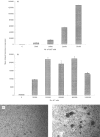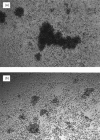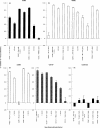Molecular characterization of U937-dependent T-cell co-stimulation
- PMID: 10233676
- PMCID: PMC2326713
- DOI: 10.1046/j.1365-2567.1999.00670.x
Molecular characterization of U937-dependent T-cell co-stimulation
Abstract
U937 cells provide a co-stimulatory signal for CD3-mediated T-cell activation which is independent of the CD28/CD80/CD86 interaction. This study set out to identify which molecules contribute to this co-stimulatory activity. Monoclonal antibodies (mAb) to the known accessory molecules CD11a, CD18, CD54 and CD45, all inhibited T-cell proliferation. Although CD11a/18 mAb inhibited U937/T-cell cluster formation as well as proliferation, CD45 enhanced the size of the clusters formed, suggesting that this was not the only mechanism of inhibition. The alternative co-stimulatory pathway provided by U937 cells preferentially stimulated a response in the CD18+ T-cell population, and this reflected the reduced sensitivity of CD8+ T cells to CD28-mediated activation. Monoclonal antibodies to three molecules, CD53, CD98 and CD147, also inhibited U937-dependent T-cell proliferation. The mAb to CD98 and CD147 were inhibitory when prepulsed on to the U937 cells, suggesting an effect mediated by these molecules on the antigen-presenting cell.
Figures








Similar articles
-
Novel molecular mechanisms of dendritic cell-induced T cell activation.Int Immunol. 2000 Jul;12(7):1051-61. doi: 10.1093/intimm/12.7.1051. Int Immunol. 2000. PMID: 10882417
-
Activation of human dendritic cells by porcine aortic endothelial cells: transactivation of naïve T cells through costimulation and cytokine generation.Transplantation. 2001 Nov 15;72(9):1563-71. doi: 10.1097/00007890-200111150-00015. Transplantation. 2001. PMID: 11707746
-
The role of CD11a/CD18-CD54 interactions in human T cell-dependent B cell activation.J Immunol. 1991 Jan 15;146(2):492-9. J Immunol. 1991. PMID: 1670945
-
Chimeric scFv/gamma receptor-mediated T-cell lysis of tumor cells is coregulated by adhesion and accessory molecules.Int J Cancer. 1998 Jul 17;77(2):181-7. doi: 10.1002/(sici)1097-0215(19980717)77:2<181::aid-ijc2>3.0.co;2-m. Int J Cancer. 1998. PMID: 9650549
-
Surface antigen CD98(4F2): not a single membrane protein, but a family of proteins with multiple functions.J Membr Biol. 2000 Feb 1;173(3):165-77. doi: 10.1007/s002320001017. J Membr Biol. 2000. PMID: 10667913 Review. No abstract available.
Cited by
-
T-lymphocyte recovery and function after cord blood transplantation.Immunol Res. 2011 Apr;49(1-3):56-69. doi: 10.1007/s12026-010-8194-6. Immunol Res. 2011. PMID: 21128006 Free PMC article.
-
Interleukin-7 permits Th1/Tc1 maturation and promotes ex vivo expansion of cord blood T cells: a critical step toward adoptive immunotherapy after cord blood transplantation.Cancer Res. 2010 Jul 1;70(13):5249-58. doi: 10.1158/0008-5472.CAN-09-2860. Epub 2010 Jun 8. Cancer Res. 2010. PMID: 20530666 Free PMC article.
-
Metabolic activation-related CD147-CD98 complex.Mol Cell Proteomics. 2005 Aug;4(8):1061-71. doi: 10.1074/mcp.M400207-MCP200. Epub 2005 May 18. Mol Cell Proteomics. 2005. PMID: 15901826 Free PMC article.
-
Beta1 integrins show specific association with CD98 protein in low density membranes.BMC Biochem. 2001;2:10. doi: 10.1186/1471-2091-2-10. Epub 2001 Oct 15. BMC Biochem. 2001. PMID: 11696247 Free PMC article.
-
CD147 immunoglobulin superfamily receptor function and role in pathology.Exp Mol Pathol. 2007 Dec;83(3):283-95. doi: 10.1016/j.yexmp.2007.08.014. Epub 2007 Sep 7. Exp Mol Pathol. 2007. PMID: 17945211 Free PMC article. Review.
References
-
- Schwartz RH. Costimulation of T lymphocytes: the role of CD28, CTLA-4, and B7/BB1 in interleukin-2 production and immunotherapy. Cell. 1992;71:1065. - PubMed
-
- Schwartz RH. T-lymphocyte recognition of antigen in association with gene products of the major histocompatibility complex. Annu Rev Immunol. 1985;3:237. - PubMed
-
- Weiss A, Iwashima M, Irving B, et al. Molecular and genetic insights into T cell antigen receptor signal transduction. Adv Exp Med Biol. 1994;365:53. - PubMed
-
- Jenkins MK, Johnson JG. Molecules involved in T-cell costimulation. Curr Opin Immunol. 1993;5:361. - PubMed
Publication types
MeSH terms
Substances
Grants and funding
LinkOut - more resources
Full Text Sources
Other Literature Sources
Research Materials
Miscellaneous

